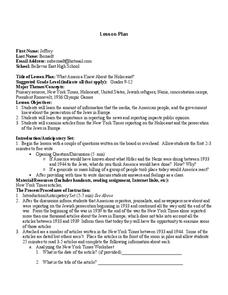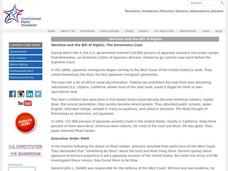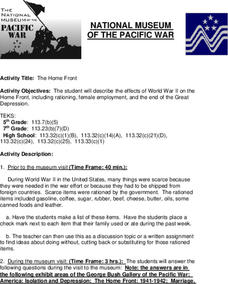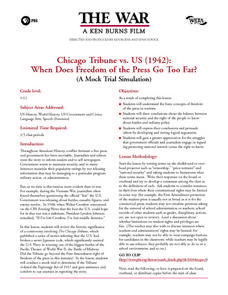National First Ladies' Library
There's Only How Much? Rationing in World War II
Students discuss the idea of rationing as a restriction on the amount of something or the frequency with which something may be purchased or used in order to contribute to the greater good of the group which was what happened during...
National Endowment for the Humanities
Soviet Espionage in America
The war against Communism and Joseph McCarthy’s place in it are the focus of a series of three lessons examining postwar America from 1945-1950. This first lesson asks groups to read an introduction that describes the Verona Project and...
Curated OER
Lesson 3: Japan's "Southern Advance" and the March toward War, 1940-1941
High school historians interpret historical evidence presented in primary resources to decide if the southern advance was a reckless step toward war, or if it was reasonable. They research the Japanese southern advance tactics during the...
Curated OER
Axis and Allies World War II Simulation
Learners investigate World War II through the computer game Axis and Allies. They discuss the basics of World War II before playing the game, spend eight weeks playing the game that is a simulation of World War II, and write a report...
Curated OER
Firestorms: The Bombing of Civilians in World War II: War, Ethics, Guernica, Precision Bombing
Students explore the history, rationale and ethics of civilian bombing in times of war. They consider war strategy, the laws and conventions of war and international implications.
Curated OER
Meet Molly An American Girl
Students examine concepts of personal finance. In this personal finance lesson, students use Valerie Tripp's, Meet Molly, An American Girl, to learn about saving and spending after World War II. They compare financial decisions after...
Curated OER
The Declaration of War Against Japan and Just War Theory
Students examine the attack on Pearl Harbor and how it changed the history of the United States. After watching a video from "The War", they discuss the characteristics of a "just war" and identify the laws in international warfare. ...
Curated OER
Post-War Suburbanization: Causes and Interpretations
In this teaching American history worksheet, students examine a primary source document regarding post-World War II suburbanization. Students discuss their impressions of the document.
Curated OER
What America Knew About the Holocaust?
Learners examine American involvement in World War II. In this World War II lesson, students discuss the Holocaust and its implications. Learners read New York Times articles regarding the treatment of Jews during the war. Students infer...
University of California
Decolonization
The ripple effect from one small event can impact many others. Young historians research the ripple effect World War II had on decolonization in the second installment of an eight-part series. Through primary and secondary documents as...
Curated OER
What Concepts are being presented
World War II, WWII, the Holocaust, the Rise of the Nazi Empire, Concentration Camps, the effect on children. The first 9 slides are of images and scenes of WWII, Black and white photography Slides 10 to 20 show present day photos of...
Curated OER
Diplomacy in the Inter-War Years (5)
In this online interactive world history worksheet, students answer 10 matching questions regarding the years between World Wars I and II. Students may submit their answers to be scored.
Curated OER
Wartime and the Bill of Rights: The Korematsu Case
Learners examine the balance between civil liberties and protection. In this national security lesson, students explore the Korematsu case which references the Japanese internment camps of World War II. Learners draw comparisons between...
Curated OER
Double V Campaign: Victory at Home and Victory Abroad
Students write a persuasive essay as if they were an African American in World War II and decide if they would contribute war bonds or not. In this World War II lesson plan, students study the segregation of World War II and the unity...
Curated OER
The Home Front
Young scholars describe the effects of World War II on the Home Front, including rationing, female employment, and the end of the Great Depression. They interview someone who was at home during World War II and ask them how the war...
Curated OER
Iwo Jima: Forgotten Valor
Students explore the nature of island combat on Iwo Jima during World War II. They examine the association between the Pacific Theater of World War II and Iwo Jima. Students evaluate Charles Lindberg's oral history, propaganda posters,...
Curated OER
Beauty Behind Barbed Wire
Students investigate the issue of racism against the Japanese during the start of World War II. They use the artwork of Estelle Ishigo to create context for the lesson plan and see how it provides a look into the life she experienced...
Curated OER
Chicago Tribune vs. US (1942): When Does Freedom of the Press Go Too Far?
Students define freedom of the press in peace and war time. As a class, they identify the need for the public to be informed, but discuss where the line should be drawn to protect national security. They develop their arguments and...
Curated OER
Baseball Challenge: 5th Grade Social Studies
Quickly review facts relating to U.S. History in a Baseball Challenge presentation. The information relates to branches of government, the Vietnam War, WWII, and other key events.
Curated OER
Work in Post-World War II Wisconsin
Learners explore the changing nature of work in postwar America by analyzing a variety of sources and conducting their own research. They answer the question, "How did work change in Wisconsin after World War II?"
Curated OER
Miss America
The first part of this article by PBS on the Miss America pageants can be used in a health class when it's time to talk about body image. There are links to related articles. There are some great questions for discussion. There are ideas...
Curated OER
Dr. Seuss Takes on Charles Lindbergh
Students study the leaders of the isolationist movement within the United States and the causes of the isolationist movement, they recognize and compare the perceptions of both the isolationists within the US and those who took a more...
Curated OER
The White Line - A One Act Play
Students discuss amendments of the Constitution that cover due process and discuss them in relation to the play "The White Line". They determine how national security measures conflict with the issues of due process during wartime. They...
Curated OER
Rethinking Perpetrators, Bystanders, and Rescuers: The Case of Max Schmeling
High schoolers examine the life and actions of Max Schmeling during World War II. They read and analyze an article, compare/contrast Schmeling's choices with other people during this time period, and write a journal response.























